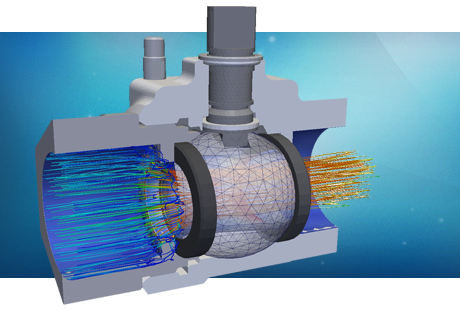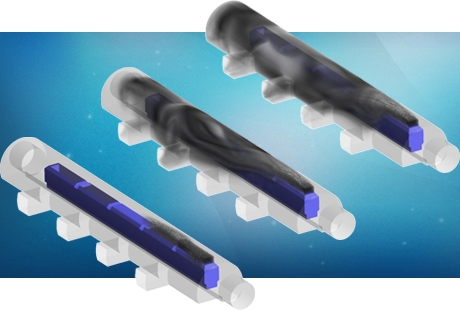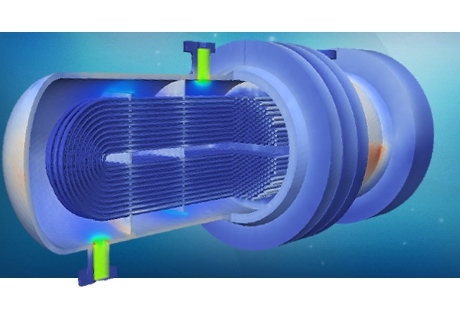CFD based thermal evaluation of choke valve (Joule-Thomson cooling)
Offshore hydrocarbon production involves the extraction of multi-phase and multi-component fluids from a high pressure and high temperature reservoir, across a varied temperature and pressure environment, up to the surface production facility. The extreme operating thermal and pressure conditions create a unique challenge for engineering designs in terms of material reliability and safety.
Some of the challenging areas are; well control procedures such as shut-in to contain a well kick during drilling; and well start-up procedures such as blow-down which aim to safely resume normal operation after a shut-in period. A failure in these procedures would culminate in a subsea blowout which is the uncontrolled release of production fluids.

Significant engineering analysis of key components is therefore required in order to reduce the risk of failure during these very high pressure events. In addition to containing the design must be able to safely operate under the challenging thermal conditions that accompany these events.
Due to the extreme pressure and temperature conditions involved in these designs as well as the wide range of operating conditions to consider, numerical simulation can play a vital role in supporting design optimization and accelerating product development while reducing development costs.
PRE Technologies’ engineering team with their wide range of CFD/FEA expertise and subsea experience is a valuable partner in this process. This article resents a case study to demonstrate these capabilities and illustrate some of the valuable insights that CFD analysis can bring to subsea component design.
The wellhead choke valve is one of the main control components used to manage the flow of fluids through the subsea Xmas tree . The amount of energy dissipated by the choke can be enormous and special care should be taken to ensure a successful design able to safely operate under the most demanding conditions.
The sudden expansion of the production fluid also leads to supersonic flows and cryogenic temperatures developing downstream of the choke which the downstream piping and equipment must be able to withstand. This temperature change due a nearly adiabatic expansion is referred to as Joule-Thomson (J-T) cooling. The very low temperatures resulting from a J-T cooling event may result in ice formation which subsequently leads to undesirable consequences such as the damage of seals and other sensitive equipment like thermal probes. The use of 3D modeling techniques such as CFD is preferred over traditional 1D PVT models and pipeline models due to the powerful combination of accurate representation of the physics and a precise geometric representation that CFD offers, leading to a more realistic design.

In the case study presented here, an unsteady 3D CFD model is used to simulate the pressure drop across the choke valve during a gas blowdown event. To accurately simulate the J-T cooling effect, the 3D compressible Navier-Stokes equations are solved together with an equation of state to characterize the fluid thermodynamic behavior. The production fluid is modelled as Methane gas and thermodynamically characterized using a real-gas using the Peng-Robinson equation of state.
The Peng-Robinson equation of state provides a more accurately representation of the J-T cooling effect than the ideal gas model which fails within the expected range of pressures and temperatures expected. The variation in heat capacity of Methane over the operating range of the case is modeled using a quadratic function of the temperature which makes it possible to account for the changes in thermal inertia of the fluid over the wide temperature range anticipated. An unsteady CFD simulation is used to capture the inherently transient nature of the startup procedure. Thermal conditions for the seabed are applied as initial conditions and the transient model is used to simulate the time scale of interest. The flow field may be numerically unstable so different stabilization techniques are required in order to get a well posed and converged solution.
The Xmas tree and choke geometry used in the CFD case study is shown in the next figure. The geometry represents a portion of a production tree with an inlet flow passing through a wing block prior to traveling through the choke and into downstream piping. A section of the downstream piping system is included in order to capture the cryogenic expansion of the fluid and the subsequent temperature field. The valve position is set to fully open mode to get a worst case thermal scenario, but other valve positions may be model in order to obtain the full range of flow rates and pressure drops that can be achieved through different configurations.

Boundary conditions for this model include an inlet flow from the well driven by a shut-in pressure of 180 bar and an outlet pressure of 20 bar in the downstream piping, leading to a pressure drop of 160 bars across the choke. A sea temperature of 5 °C is assumed together with a heat transfer coefficient applied to the external surface to model the effects of forced or natural convection.
The conjugate heat transfer between the production fluid and different solid materials is accurately modelled by explicitly representing the various solid material components such as steel, Inconel, HNBR rubber seals and their respective thermal properties.
Results show the presence of the choking effect as the gas velocity exceeds the speed of sound in the choke region. Due to this chocking effect, a 180 bar pressure drop is observed across the choke and a supersonic flow is created through the valve opening (due to the vena contracta effect) and in the downstream pipework. This supersonic flow is illustrated in the figure on the right using the Mach number contours on a section through the xmas tree.
A key desired output of the analysis is the final normalized temperature as a result of J-T cooling effect. As shown in the next figure, a steep temperature drop to below -60 ° C is observed in some regions of the downstream steel equipment and within sensor housings and connectors. This steep temperature drop pushes the material temperature limits of the most brittle materials and potentially creating icing effects and hydrate formation.

The case study presented in this article highlights some of PRE Technologies’ in-house technical expertise in providing better insight into extreme events like J-T cooling which are critical to a number of subsea component designs. We also have the capability to reliably model other related physical-thermal phenomena such as hydrate formation and peak temperature analysis using 3D CFD techniques.
Using our extensive background in computational mechanics, PRE Technologies has helped clients to accurately predict component performance under a wide range of physical conditions in order to; ensure safe operation, support design optimization and accelerate product development while reducing costs.
Please see other related articles and case studies available at the PRE Technologies website. We are constantly updating our website and aim to have a wider range of case studies in the future, so do keep in touch.
Keep your curiosity in good shape.
For more information on this or any other technical white paper, please contact us.







